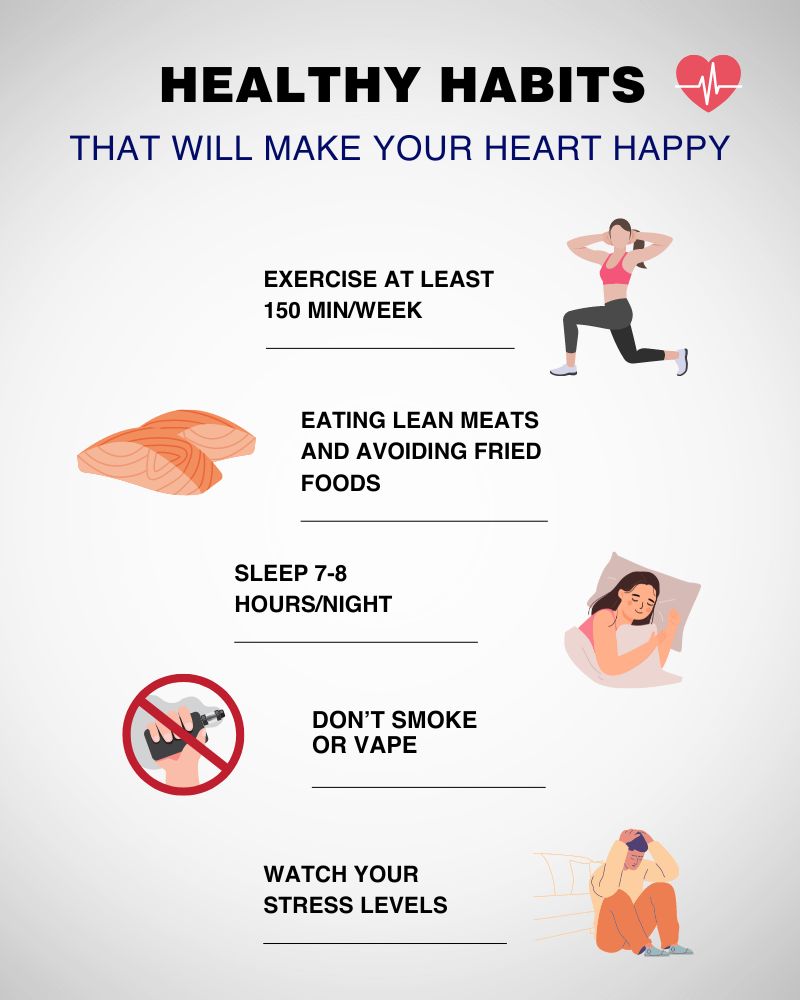It’s officially February – winter winds are still blowing but there are some highlights to look forward to. The Super Bowl on the 11th promises to deliver some excitement, couples will enjoy some special warmth on Valentine’s Day, and this year we have a quadrennial Leap Day to keep the calendar interesting. There’s one more highlight of February: American Heart Month.
American Heart Month is a time dedicated to informing the public about heart disease, its risk factors, and ways to prevent it. Most of the educational materials around heart health center on getting/staying active and eating right. This year, we’ll share some of the startling impacts of air quality on cardiovascular health.
Ladies: Listen To Your Heart and Speak Up for Your Health
First, we’d be remiss if we didn’t discuss the Center for Disease Control’s (CDC) Division for Heart Disease and Stroke Prevention (DHDSP) focus for Heart Month 2024 – “encouraging women to listen to their hearts and speak up for their health.”1
Although men’s health is equally important, the campaign is specifically aimed at women because of the high rate of heart-related illness and death for women in the United States. This phenomenon is avoidable and, therefore, unacceptable. Part of the problem is that almost half of women in the U.S. are unaware that heart disease is the leading cause of death for women, as well as a contributing factor to stroke and heart attack.2
The goal is to shed light on this issue to prevent delayed recognition, diagnosis, and treatment for cardiac events – such as blood clots and heart attacks.
Many of you reading this will also note that February is Black History Month. It’s important to note that the disparities in women’s heart health worsen due to the factors of race, socio-economic status, and ethnicity.3 Everyone – health care professionals and private individuals – can help by spreading the word this February and all year long.
Air Quality and Heart Health
One of the most significant influences on cardiovascular health is air quality. Prolonged exposure to high levels of air pollution – indoors and outdoors, especially in urban areas with persistent pollution – has been associated with an increased risk of cardiovascular mortality over the long term.
Here are a few examples of how poor air quality negatively affects cardiovascular health:
- Inflammation and Artery Damage: Fine particulate matter (PM2.5) and other common pollutants in the air can be inhaled into the lungs and then enter the bloodstream. Once in the bloodstream, they may trigger inflammation, leading to damage to the arteries. This can also cause the development of atherosclerosis, the hardening and narrowing of the arteries, which contributes to heart attack and heart failure.4
- Increased Blood Pressure: Traffic-related air pollution (TRAP) and elevated levels of ground-level ozone (O3) are associated with an increased risk of high blood pressure, a significant risk factor for heart disease and stroke.
- Plaque Instability: Air pollution contributes to plaque instability in the arteries, which is when plaque can easily dislodge from the heart muscle. This increases the risk of thrombosis (formation of blood clots), which can lead to heart attacks or strokes.
Vulnerable populations, including seniors and those with pre-existing health conditions, are more susceptible to the cardiovascular effects of air pollution. Children exposed to air pollution may also experience cardiovascular issues later in life.5

Clinically Proven to Make Hearts Happy
Along with adopting a heart-healthy lifestyle (including regular exercise and a low-fat diet), reducing exposure to air pollution is a significant way to ensure heart health. Austin Air is proud that our products have been proven to contribute to better cardiovascular outcomes in multiple clinical trials.
CLEAN Air Heart Ancillary Study
Researchers at the Johns Hopkins University Division of Pulmonary and Critical Care Medicine conducted a study to examine indoor air pollution and cardiovascular issues in COPD patients, featuring the use of Austin Air cleaners to improve indoor air quality (IAQ).6
For this study, former smokers with moderate to severe COPD were recruited for a six-month randomized trial. The patients with air cleaners had better outcomes than those without. It was the first study in the United States to establish a link between the heart function of people with COPD and household air pollutants, specifically particulate matter (PM).
The authors also concluded that there are potential cardiovascular benefits of air cleaners in the home for all people.
Reducing Ambient Traffic-Related Air Pollution and Lowering Blood Pressure
Scientists from Tufts University and Franklin W. Olin College of Engineering wanted to examine if changes to blood pressure can be associated with reduced exposure to traffic-related air pollution (TRAP).7 Austin Air HealthMates were brought in to reduce indoor TRAP concentrations, and infiltration was also limited through windows and doors.
The participants in this study had no heart issues or other known health problems. None of the participants smoked or lived with a smoker. And none of the subjects could work somewhere where they experienced extended exposure to combustion, like a commercial kitchen or taxi. Each person was exposed to low, medium, and high TRAP concentrations in a building located near an interstate highway. Pollutant concentrations were monitored continuously. Heart rate and blood pressure were measured every 10 minutes.
The primary outcome was a change in systolic blood pressure (SBP) – starting within 20 minutes of exposure. The longer the exposure, the more SBP increases. The amount of increase was related to the level of exposure. SBP is considered to be the most significant predictor of risk, adding extra concern to the impact of air pollution on heart health.
In contrast, exposure to TRAP was reduced with the use of Austin Air cleaners.
Specifically, the authors state:
Our results suggest that use of HEPA filtration may be an effective intervention for reducing cardiovascular risk from exposure to TRAP. If the benefits that we observed can be sustained under everyday living conditions, it might be possible to reduce adverse effects of TRAP on SBP for near-highway residents and commuters.
This research has huge implications for residences and schools near highways, where emissions from traffic are highest.

Moving Forward
At Austin Air, we regularly remind our readers of the importance of a healthy lifestyle for whole body health.
The following will help your heart and the rest of your systems:
- Get your exercise – about 150 minutes per week
- Eating healthy foods – get lean meats, avoid fried and high-fat foods
- Sleep – 7 to 9 hours per night is recommended for most adults.
- Don’t smoke – there’s no way around it; smoking and vaping are bad for you.
- Watch your stress levels – which is one more reason to exercise.
Finally, the facts are clear – exposure to air pollution is harmful to your heart. However, the research has shown – using an Austin Air cleaner can have an almost immediate improvement to your heart health. This American Heart Month, commit to a healthier heart with an Austin Air cleaner.
REFERENCES
1 American Heart Month 2024 Toolkits (2024, January 12). Centers for Disease Control and Prevention. https://www.cdc.gov/heartdisease/american_heart_month.htm.
2 Mosca L, Hammond G, Mochari-Greenberger H, Towfighi A, Albert MA, American Heart Association Cardiovascular Disease and Stroke in Women and Special Populations Committee of the Council on Clinical Cardiology, Council on Epidemiology and Prevention, Council on Cardiovascular Nursing, Council on High Blood Pressure Research, and Council on Nutrition, Physical Activity and Metabolism. Fifteen-year trends in awareness of heart disease in women: Results of a 2012. American Heart Association national survey. Circulation. 2013;127(11):1254–63, e1–293. doi: 10.1161/CIR.0b013e318287cf2f.
3 Bey GS, Jesdale B, Forrester S, Person SD, Kiefe C. Intersectional effects of racial and gender discrimination on cardiovascular health vary among black and white women and men in the CARDIA study. SSM – Population Health. 2019;8:100446. doi: 10.1016/j.ssmph.2019.100446.
4 Araujo JA, Nel AE. Particulate matter and atherosclerosis: role of particle size, composition and oxidative stress. Part Fibre Toxicol. 2009 Sep 18;6:24. doi: 10.1186/1743-8977-6-24.
5 Prunicki, M., Cauwenberghs, N., Lee, J. et al. Air pollution exposure is linked with methylation of immunoregulatory genes, altered immune cell profiles, and increased blood pressure in children. Sci Rep 11, 4067 (2021). doi: 10.1038/s41598-021-83577-3.
6 Raju S, Woo H, Koehler K, et al. Indoor Air Pollution and Impaired Cardiac Autonomic Function in Chronic Obstructive Pulmonary Disease. Am J Respir Crit Care Med. 2023 Mar 15;207(6):721-730. doi: 10.1164/rccm.202203-0523OC. PMID: 36288428.
7 Hudda N, Eliasziw M, Hersey SO, et al. Effect of Reducing Ambient Traffic-Related Air Pollution on Blood Pressure. Hypertension, 2021, March 3,77(3), 823–832. doi: 0.1161/hypertensionaha.120.15580.
